Improving the Luminescence Performance of Monolayer MoS2 by Doping Multiple Metal Elements with CVT Method
Abstract
:1. Introduction
2. Materials and Methods
3. Results and Discussion
4. Conclusions
Supplementary Materials
Author Contributions
Funding
Institutional Review Board Statement
Informed Consent Statement
Data Availability Statement
Conflicts of Interest
References
- Ye, M.; Zhang, D.; Yap, Y.K. Recent advances in electronic and optoelectronic devices based on two-dimensional transition metal dichalcogenides. Electronics 2017, 6, 43. [Google Scholar] [CrossRef]
- Jariwala, D.; Sangwan, V.K.; Lauhon, L.J.; Marks, T.J.; Hersam, M.C. Emerging device applications for semiconducting two-dimensional transition metal dichalcogenides. ACS Nano 2014, 8, 1102–1120. [Google Scholar] [CrossRef]
- Wu, M.; Xiao, Y.; Zeng, Y.; Zhou, Y.; Zeng, X.; Zhang, L.; Liao, W. Synthesis of two-dimensional transition metal dichalcogenides for electronics and optoelectronics. InfoMat 2021, 3, 362–396. [Google Scholar] [CrossRef]
- Cai, Z.; Shen, T.; Zhu, Q.; Feng, S.; Yu, Q.; Liu, J.; Tang, L.; Zhao, Y.; Wang, J.; Liu, L.; et al. Dual-Additive Assisted Chemical Vapor Deposition for the Growth of Mn-Doped 2D MoS2 with Tunable Electronic Properties. Small 2020, 16, 1903181. [Google Scholar] [CrossRef]
- Chaves, A.; Azadani, J.G.; Alsalman, H.; da Costa, D.G.; Frisenda, R.; Chaves, A.J.; Song, S.H.; Kim, Y.D.; He, D.; Zhou, J.; et al. Bandgap engineering of two-dimensional semiconductor materials. NPJ 2D Mater. Appl. 2020, 4, 29. [Google Scholar] [CrossRef]
- Tedstone, A.A.; Lewis, D.J.; O’Brien, P. Synthesis, properties, and applications of transition metal-doped layered transition metal dichalcogenides. Chem. Mater. 2016, 28, 1965–1974. [Google Scholar] [CrossRef]
- Ma, Z.; Ren, C.; Wu, Y.; Qiu, H.; Liu, H.; Hu, Z.; Wu, Y. Dopant-Induced Giant Photoluminescence of Monolayer MoS2 by Chemical Vapor Transport. Adv. Mater. Interfaces 2022, 9, 2200431. [Google Scholar] [CrossRef]
- Pi, X. Doping silicon nanocrystals with boron and phosphorus. J. Nanomater. 2012, 2012, 912903. [Google Scholar] [CrossRef]
- Kong, L.; Liu, Y.; Dong, L.; Zhang, L.; Qiao, L.; Wang, W.; You, H. Enhanced red luminescence in CaAl12O19: Mn4+ via doping Ga3+ for plant growth lighting. Dalton Trans. 2020, 49, 1947–1954. [Google Scholar] [CrossRef]
- Zhang, J.; Zhong, A.; Huang, G.; Zhang, J.; Zhong, A.; Huang, G.; Yang, M.; Li, D.; Teng, M.; Han, D. Enhanced efficiency with CDCA co-adsorption for dye-sensitized solar cells based on metallosalophen complexes. Sol. Energy 2020, 209, 316–324. [Google Scholar] [CrossRef]
- Pham, V.P.; Yeom, G.Y. Recent advances in doping of molybdenum disulfide: Industrial applications and future prospects. Adv. Mater. 2016, 28, 9024–9059. [Google Scholar] [CrossRef] [PubMed]
- Li, M.; Wu, X.; Guo, W.; Liu, Y.; Xiao, C.; Ou, T.; Zheng, Y.; Wang, Y. Controllable p-type doping of monolayer MoS2 with tantalum by one-step chemical vapor deposition. J. Mater. Chem. C 2022, 10, 7662–7673. [Google Scholar] [CrossRef]
- Zhang, J.; Tian, X.; Liu, M.; Guo, H.; Zhou, J.; Fang, Q.; Liu, Z.; Wu, Q.; Lou, J. Cobalt-modulated molybdenum–dinitrogen interaction in MoS2 for catalyzing ammonia synthesis. J. Am. Chem. Soc. 2019, 141, 19269–19275. [Google Scholar] [CrossRef] [PubMed]
- Wang, Z.; Wang, W.; Yang, Y.; Li, W.; Feng, L.; Zhang, J.; Wu, L.; Zeng, G. The structure and stability of molybdenum ditelluride thin films. Int. J. Photoenergy 2014, 2014, 956083. [Google Scholar] [CrossRef]
- Kochat, V.; Apte, A.; Hachtel, J.A.; Kumazoe, H.; Krishnamoorthy, A.; Susarla, S.; Idrobo, J.C.; Shimojo, F.; Vashishta, P.; Kalia, R.; et al. Re doping in 2D transition metal dichalcogenides as a new route to tailor structural phases and induced magnetism. Adv. Mater. 2017, 29, 1703754. [Google Scholar] [CrossRef] [PubMed]
- Suh, J.; Park, T.E.; Lin, D.Y.; Fu, D.; Park, J.; Jung, H.J.; Chen, Y.; Ko, C.; Jang, C.; Sun, Y.; et al. Doping against the native propensity of MoS2: Degenerate hole doping by cation substitution. Nano Lett. 2014, 14, 6976–6982. [Google Scholar] [CrossRef]
- Suh, J.; Tan, T.L.; Zhao, W.; Park, J.; Lin, D.; Park, T.; Kim, J.; Jin, C.; Saigal, N.; Ghosh, S.; et al. Reconfiguring crystal and electronic structures of MoS2 by substitutional doping. Nat. Commun. 2018, 9, 199. [Google Scholar] [CrossRef]
- Lin, X.; Ni, J. Charge and magnetic states of Mn-, Fe-, and Co-doped monolayer MoS2. J. Appl. Phys. 2014, 116, 044311. [Google Scholar] [CrossRef]
- Fang, Q.; Zhao, X.; Huang, Y.; Xu, K.; Min, T.; Chu, P.K.; Ma, F. Structural stability and magnetic-exchange coupling in Mn-doped monolayer/bilayer MoS2. Phys. Chem. Chem. Phys. 2018, 20, 553–561. [Google Scholar] [CrossRef]
- Ramasubramaniam, A.; Naveh, D. Mn-doped monolayer MoS2: An atomically thin dilute magnetic semiconductor. Phys. Rev. B 2013, 87, 195201. [Google Scholar] [CrossRef]
- Kadam, K.D.; Rehman, M.A.; Kim, H.; Rehman, S.; Khan, M.A.; Patil, H.; Aziz, J.; Park, S.; Basit, M.A.; Khan, K. Enhanced and Passivated Co-doping Effect of Organic Molecule and Bromine on Graphene/HfO2/Silicon Metal–Insulator–Semiconductor (MIS) Schottky Junction Solar Cells. ACS Appl. Energy Mater. 2022, 5, 10509–10517. [Google Scholar] [CrossRef]
- Bai, G.; Yuan, S.; Zhao, Y.; Yang, Z.; Choi, S.Y.; Chai, Y.; Yu, S.F.; Lau, S.P.; Hao, J. 2D layered materials of rare-earth Er-doped MoS2 with NIR-to-NIR down-and up-conversion photoluminescence. Adv. Mater. 2016, 28, 7472–7477. [Google Scholar] [CrossRef] [PubMed]
- Zhong, J.; Han, M.; Li, C.; Li, R.; He, H. Facile and scalable fabrication process of electroluminescent filament with high luminescent efficiency. Mater. Lett. 2023, 350, 134868. [Google Scholar] [CrossRef]
- Zhang, X.; Lai, Z.; Tan, C.; Zhang, H. Solution-processed two-dimensional MoS2 nanosheets: Preparation, hybridization, and applications. Angew. Chem. Int. Ed. 2016, 55, 8816–8838. [Google Scholar] [CrossRef] [PubMed]
- Vidya, Y.S.; Lakshminarasappa, B.N. Influence of rare earth doping on microstructure and luminescence behaviour of sodium sulphate. Indian J. Mater. Sci. 2014, 2014, 675417. [Google Scholar] [CrossRef]
- Ghosh, S.K.; Srivastava, C.; Nath, S.; Celis, J.P. Simple formation of nanostructured molybdenum disulfide thin films by electrodeposition. Int. J. Electrochem. 2013, 2013, 138419. [Google Scholar] [CrossRef]
- Zhao, Y.; Ippolito, S.; Samori, P. Functionalization of 2D Materials with Photosensitive Molecules: From Light-Responsive Hybrid Systems to Multifunctional Devices. Adv. Opt. Mater. 2019, 7, 1900286. [Google Scholar] [CrossRef]
- Xie, C.; Yan, F. Flexible photodetectors based on novel functional materials. Small 2017, 13, 1701822. [Google Scholar] [CrossRef]
- Wang, J.; Zheng, H.; Xu, G.; Sun, L.; Hu, D.; Lu, Z.; Liu, L.; Zheng, J.; Tao, C.; Jiao, L. Controlled Synthesis of Two-Dimensional 1 T-TiSe2 with Charge Density Wave Transition by Chemical Vapor Transport. J. Am. Chem. Soc. 2016, 138, 16216–16219. [Google Scholar] [CrossRef]
- Raza, A.; Qumar, U.; Haider, A.; Naz, S.; Haider, J.; Ul-Hamid, A.; Ikram, M.; Ali, S.; Goumri-Said, S.; Kanoun, M.B. Liquid-phase exfoliated MoS2 nanosheets doped with p-type transition metals: A comparative analysis of photocatalytic and antimicrobial potential combined with density functional theory. Dalton Trans. 2021, 50, 6598–6619. [Google Scholar] [CrossRef]
- Sun, C.; Jiang, Y.; Cui, M.; Qiao, L.; Wei, J.; Huang, Y.; Zhang, L.; He, T.; Li, S.; Hsu, H.; et al. High-performance large-area quasi-2D perovskite light-emitting diodes. Nat. Commun. 2021, 12, 2207. [Google Scholar] [CrossRef] [PubMed]
- Li, X.; Chen, C.; Yang, Y.; Lei, Z.; Xu, H. 2D Re-Based Transition Metal Chalcogenides: Progress, Challenges, and Opportunities. Adv. Sci. 2020, 7, 2002320. [Google Scholar] [CrossRef]
- Yin, X.; Wang, Q.; Cao, L.; Tang, C.; Luo, X.; Zheng, Y.; Wong, L.; Wang, S.; Quek, S.; Zhang, W.; et al. Tunable inverted gap in monolayer quasi-metallic MoS2 induced by strong charge-lattice coupling. Nat. Commun. 2017, 8, 486. [Google Scholar] [CrossRef]
- Azizi, A.; Wang, Y.; Stone, G.; Elias, A.L.; Lin, Z.; Terrones, M.; Crespi, V.H.; Alem, N. Defect Coupling and Sub-Angstrom Structural Distortions in W1–xMoxS2 Monolayers. Nano Lett. 2017, 17, 2802–2808. [Google Scholar] [CrossRef]
- Tang, B.; Yu, Z.G.; Huang, L.; Chai, J.; Wong, S.; Deng, J.; Yang, W.; Gong, H.; Wang, S.; Ang, K.; et al. Direct n-to p-type channel conversion in monolayer/few-layer WS2 field-effect transistors by atomic nitrogen treatment. ACS Nano 2018, 12, 2506–2513. [Google Scholar] [CrossRef] [PubMed]
- Wang, S.; Robertson, A.; Warner, J.H. Atomic structure of defects and dopants in 2D layered transition metal dichalcogenides. Chem. Soc. Rev. 2018, 47, 6764–6794. [Google Scholar] [CrossRef] [PubMed]
- Wang, Q.; Lei, Y.; Wang, Y.; Liu, Y.; Song, C.; Zeng, J.; Song, Y.; Duan, X.; Wang, D.; Li, Y. Atomic-scale engineering of chemical-vapor-deposition-grown 2D transition metal dichalcogenides for electrocatalysis. Energy Environ. Sci. 2020, 13, 1593–1616. [Google Scholar] [CrossRef]
- Cui, Q.; Luo, Z.; Cui, Q.; Zhu, W.; Shou, H.; Wu, C.; Liu, Z.; Lin, Y.; Zhang, P.; Wei, S.; et al. Robust and high photoluminescence in WS2 monolayer through in situ defect engineering. Adv. Funct. Mater. 2021, 31, 2105339. [Google Scholar] [CrossRef]
- Zheng, B.; Zheng, W.; Jiang, Y.; Chen, S.; Li, D.; Ma, C.; Wang, X.; Huang, W.; Zhang, X.; Liu, H.; et al. WO3–WS2 vertical bilayer heterostructures with high photoluminescence quantum yield. J. Am. Chem. Soc. 2019, 141, 11754–11758. [Google Scholar] [CrossRef]
- Zhao, J.; Zhao, W.; Du, W.; Su, R.; Xiong, Q. Dynamics of exciton energy renormalization in monolayer transition metal disulfides. Nano Res. 2020, 13, 1399–1405. [Google Scholar] [CrossRef]
- Sun, D.; Rao, Y.; Reider, G.A.; Che, G.; You, Y.; Brézin, Y.; Harutyunyan, A.R.; Heinz, T.F. Observation of rapid exciton–exciton annihilation in monolayer molybdenum disulfide. Nano Lett. 2014, 14, 5625–5629. [Google Scholar] [CrossRef] [PubMed]
- Peng, J.; Yang, D.; Ren, C.; Jiang, Y.; Zhu, X.; Jing, F.; Qiu, H.; Liu, H.; Hu, Z. Electronic properties and carrier dynamics at the alloy interfaces of WS2xSe2−2x spiral nanosheets. Adv. Mater. 2022, 34, 2107738. [Google Scholar] [CrossRef] [PubMed]
- Luo, Z.; Zheng, W.; Luo, N.; Liu, B.; Zheng, B.; Yang, X.; Liang, D.; Qu, J.; Liu, H.; Chen, Y.; et al. Photoluminescence lightening: Extraordinary oxygen modulated dynamics in WS2 monolayers. Nano Lett. 2022, 22, 2112–2119. [Google Scholar] [CrossRef] [PubMed]
- Chen, P.; Han, W.; Zhao, M.; Su, J.; Li, Z.; Li, D.; Pi, L.; Zhou, X.; Zhai, T. Recent advances in 2D rare earth materials. Adv. Funct. Mater. 2021, 31, 2008790. [Google Scholar] [CrossRef]
- Zhang, Z.; Zhao, H.; Zhang, C.; Luo, F.; Du, Y. Rare-earth-incorporated low-dimensional chalcogenides: Dry-method syntheses and applications. InfoMat 2020, 2, 466–482. [Google Scholar] [CrossRef]
- Saponjic, Z.V.; Dimitrijevic, N.M.; Poluektov, O.G.; Chen, L.X.; Wasinger, E.; Welp, U.; Tiede, D.M.; Zuo, X.; Rajh, T. Charge separation and surface reconstruction: A Mn2+ doping study. J. Phys. Chem. B 2006, 110, 25441–25450. [Google Scholar] [CrossRef] [PubMed]
- Dash, A.; Sarkar, S.; Adusumalli, V.N.; Mahalingam, V. Microwave synthesis, photoluminescence, and photocatalytic activity of PVA-functionalized Eu3+-doped BiOX (X = Cl, Br, I) nanoflakes. Langmuir 2014, 30, 1401–1409. [Google Scholar] [CrossRef]
- Karasulu, B.; Emge, S.P.; Groh, M.F.; Grey, C.P.; Morris, A.J. Al/Ga-doped Li7La3Zr2O12 garnets as Li-ion solid-state battery electrolytes: Atomistic insights into local coordination environments and their influence on 17O, 27Al, and 71Ga NMR spectra. J. Am. Chem. Soc. 2020, 142, 3132–3148. [Google Scholar] [CrossRef]
- Zhou, J.; Zheng, G.; Liu, X.; Dong, G.; Qiu, J. Defect engineering in lanthanide doped luminescent materials. Coord. Chem. Rev. 2021, 448, 214178. [Google Scholar] [CrossRef]
- Xiong, P.; Huang, B.; Peng, D.; Viana, B.; Peng, M.; Ma, Z. Self-recoverable mechanically induced instant luminescence from Cr3+-doped LiGa5O8. Adv. Funct. Mater. 2021, 31, 2010685. [Google Scholar] [CrossRef]
- Piao, Y.; Meany, B.; Powell, L.R.; Valley, N.; Kwon, H.; Schatz, G.C.; Wang, Y. Brightening of carbon nanotube photoluminescence through the incorporation of sp3 defects. Nat. Chem. 2013, 5, 840–845. [Google Scholar] [CrossRef] [PubMed]
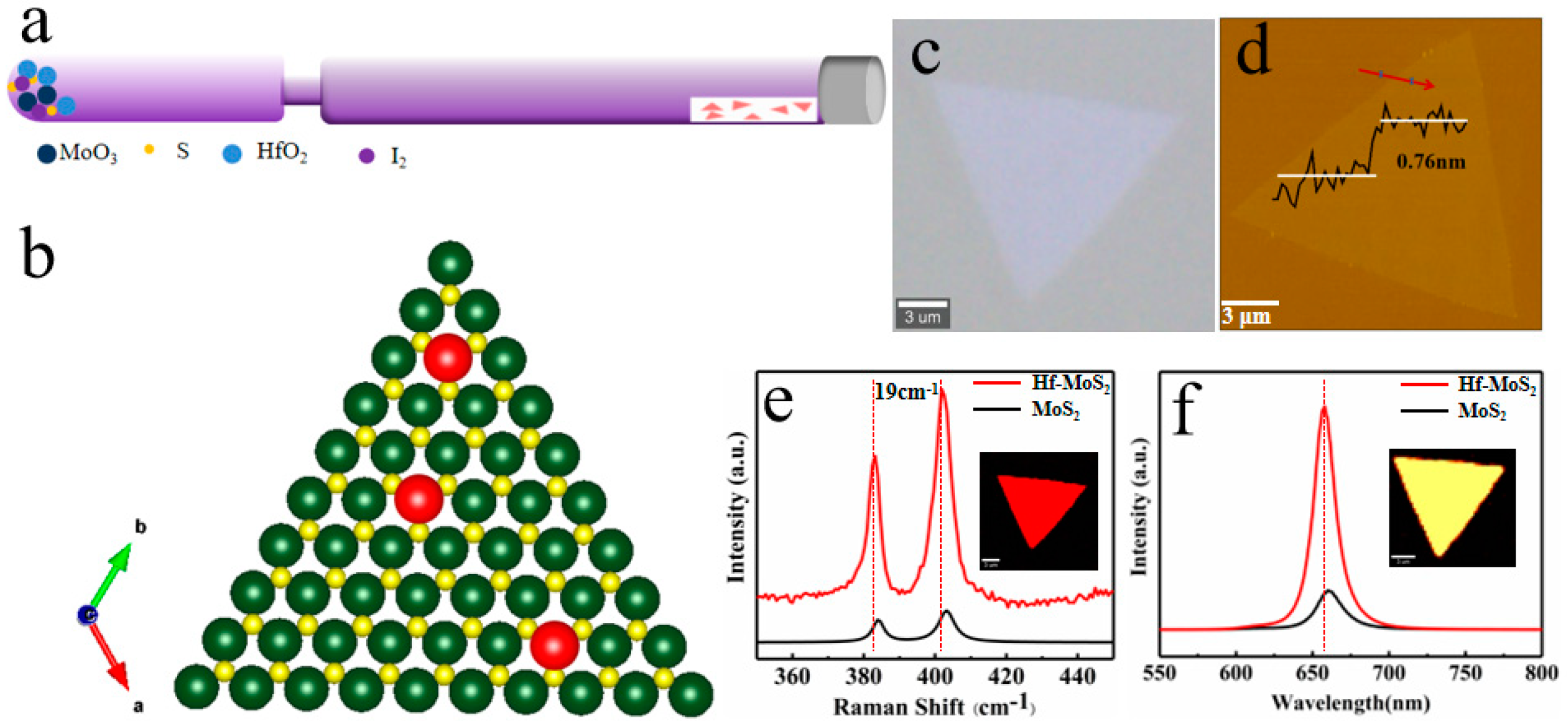
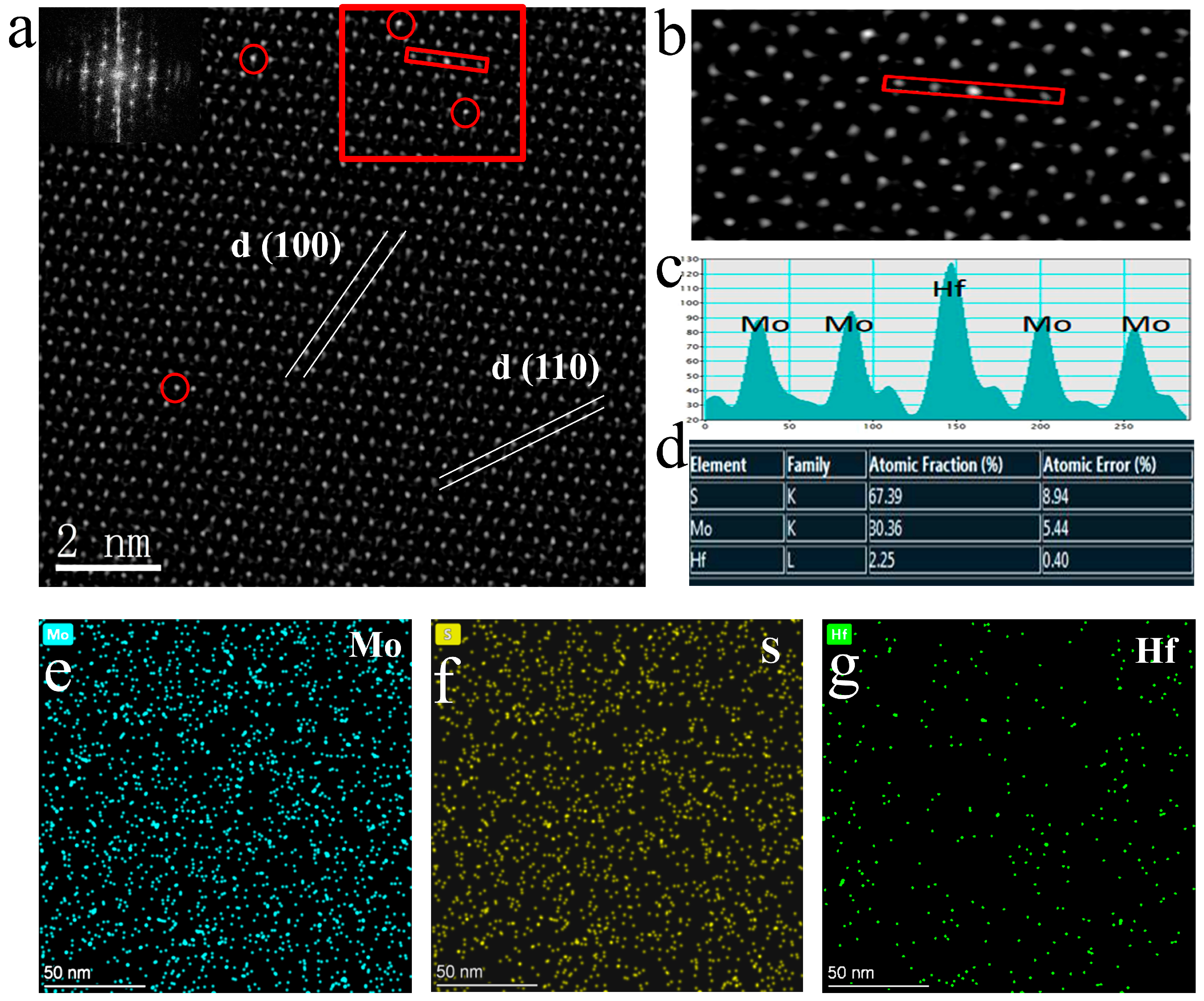
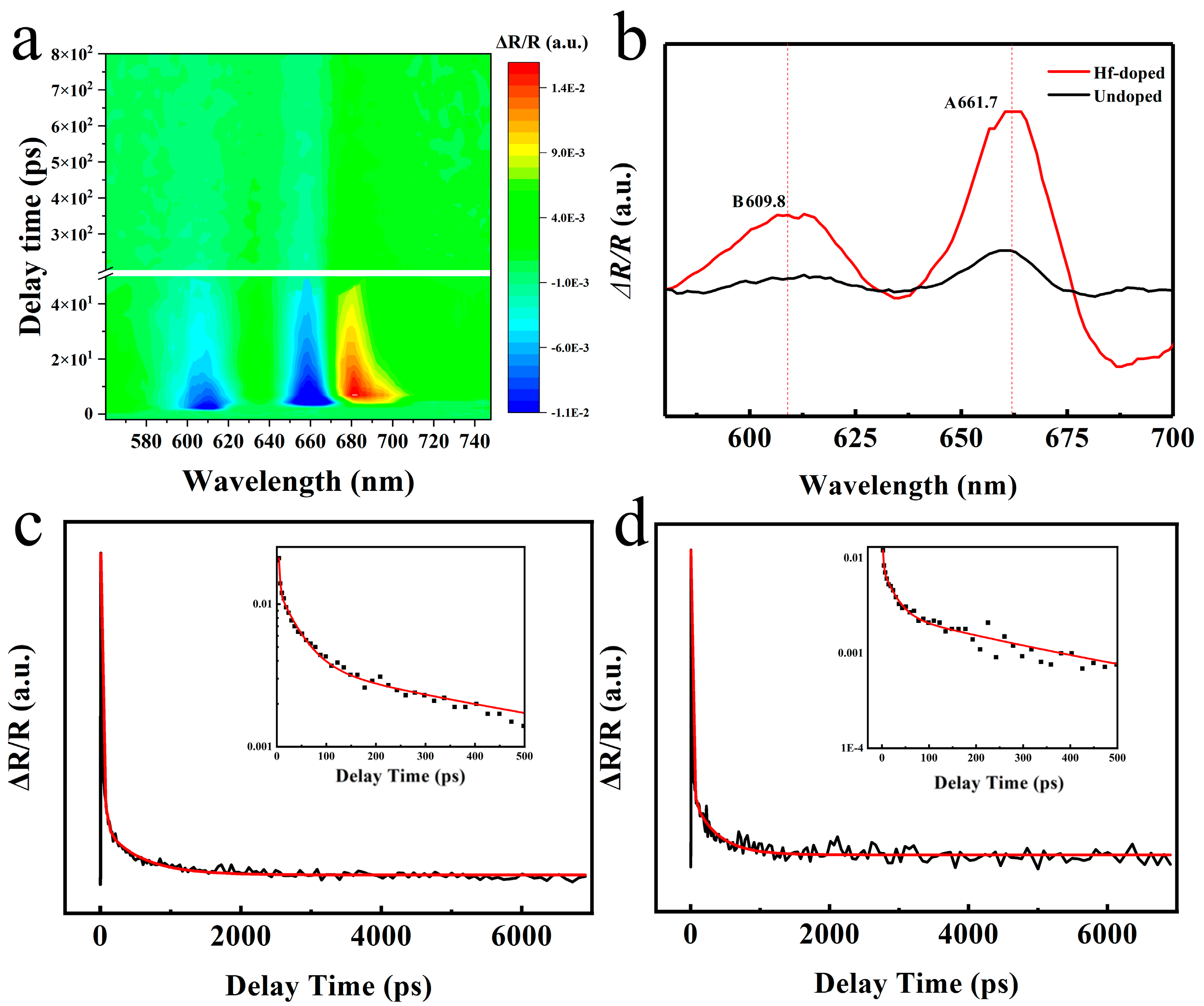
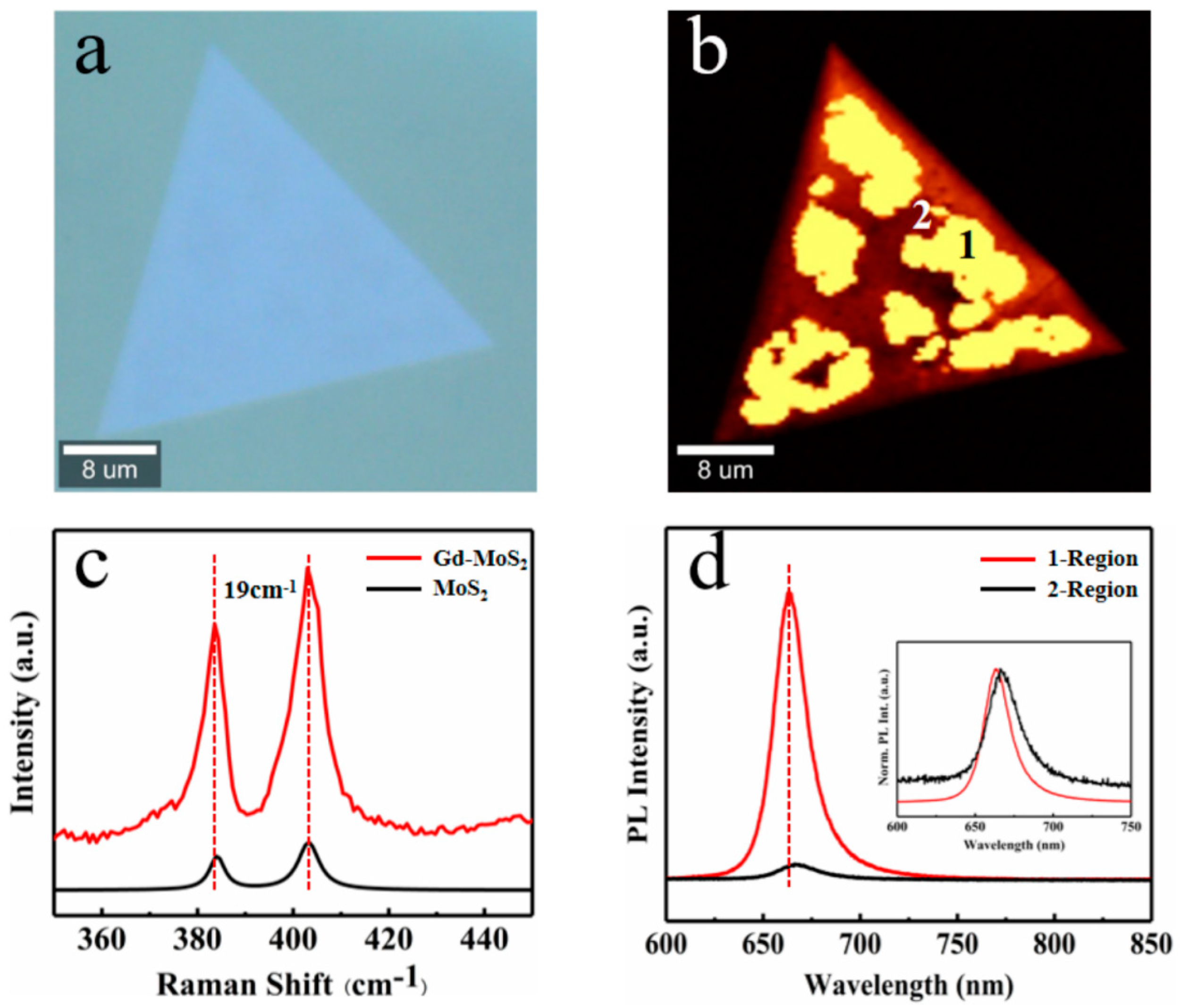

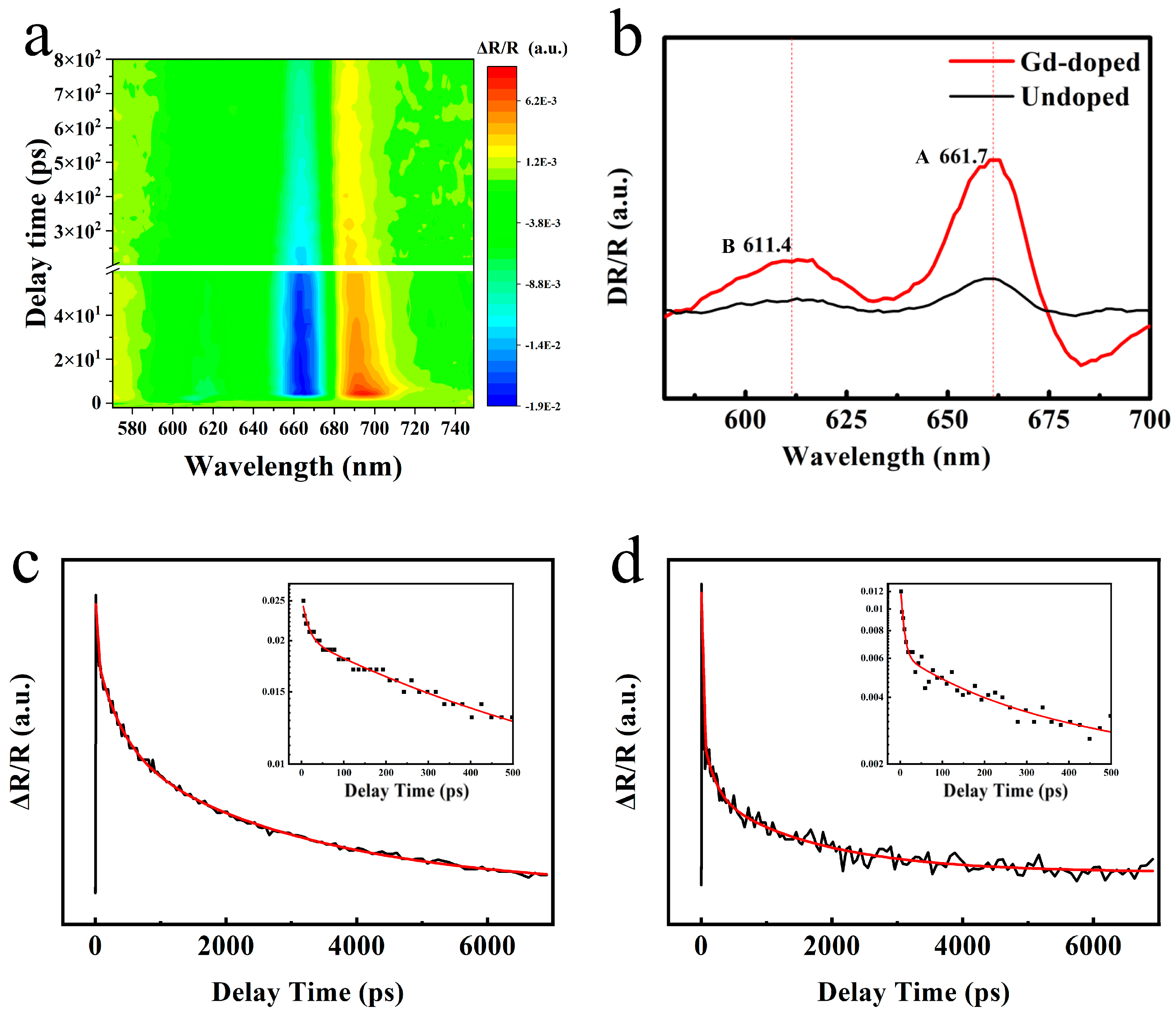
| Exciton | Monolayer | τ1 (ps) | τ2 (ps) | τ3 (ps) |
|---|---|---|---|---|
| A | Pristine | 0.91 | 24.11 | 390.08 |
| Doped | 2.14 | 40.18 | 522.78 |
| Exciton | Monolayer | τ1 (ps) | τ2 (ps) | τ3 (ps) |
|---|---|---|---|---|
| A | Pristine | 0.91 | 24.11 | 390.08 |
| Doped | 14.3 | 384.28 | 3012.01 |
Disclaimer/Publisher’s Note: The statements, opinions and data contained in all publications are solely those of the individual author(s) and contributor(s) and not of MDPI and/or the editor(s). MDPI and/or the editor(s) disclaim responsibility for any injury to people or property resulting from any ideas, methods, instructions or products referred to in the content. |
© 2023 by the authors. Licensee MDPI, Basel, Switzerland. This article is an open access article distributed under the terms and conditions of the Creative Commons Attribution (CC BY) license (https://creativecommons.org/licenses/by/4.0/).
Share and Cite
Zhao, B.; Huo, Z.; Li, L.; Liu, H.; Hu, Z.; Wu, Y.; Qiu, H. Improving the Luminescence Performance of Monolayer MoS2 by Doping Multiple Metal Elements with CVT Method. Nanomaterials 2023, 13, 2520. https://doi.org/10.3390/nano13182520
Zhao B, Huo Z, Li L, Liu H, Hu Z, Wu Y, Qiu H. Improving the Luminescence Performance of Monolayer MoS2 by Doping Multiple Metal Elements with CVT Method. Nanomaterials. 2023; 13(18):2520. https://doi.org/10.3390/nano13182520
Chicago/Turabian StyleZhao, Bojin, Zongju Huo, Lujie Li, Hongjun Liu, Zhanggui Hu, Yicheng Wu, and Hailong Qiu. 2023. "Improving the Luminescence Performance of Monolayer MoS2 by Doping Multiple Metal Elements with CVT Method" Nanomaterials 13, no. 18: 2520. https://doi.org/10.3390/nano13182520
APA StyleZhao, B., Huo, Z., Li, L., Liu, H., Hu, Z., Wu, Y., & Qiu, H. (2023). Improving the Luminescence Performance of Monolayer MoS2 by Doping Multiple Metal Elements with CVT Method. Nanomaterials, 13(18), 2520. https://doi.org/10.3390/nano13182520






